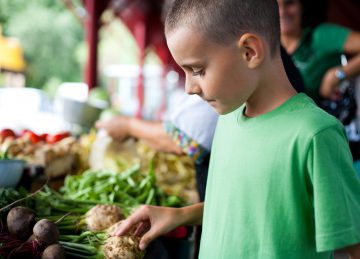 As Earth Day approaches, I’d love to see families embracing dinner talk about garbage. Wasted food – uneaten on our plates, rotting in the refrigerator, thrown out by supermarkets, abandoned on farms because it’s “ugly” – is a topic that can spark lively conversation and lead to activism.
As Earth Day approaches, I’d love to see families embracing dinner talk about garbage. Wasted food – uneaten on our plates, rotting in the refrigerator, thrown out by supermarkets, abandoned on farms because it’s “ugly” – is a topic that can spark lively conversation and lead to activism.
My well-intentioned mother used to try to coax me to “clean my plate,” by reminding me that there were starving children in Africa. This is not the best way to get the conversation going at your table! First of all, the advice to join the “clean plate club” is ill-advised: it may mean that children overeat, rather than paying attention to when they feel full. And, unless you are prepared to send uneaten food to needy people, the connection between your child’s plate and starving children far away is pretty shaky.
So, here’s a better way.
Start by informing your family about how much food is being wasted in America:
- 40% of food produced in the U.S. is thrown out
- $165 billion a year of food produced is never eaten
- A family of four throws out $2000/year of uneaten food
- Tons of food that doesn’t look pretty – a banana that doesn’t curve enough, an apple that isn’t perfectly round and red – gets left behind to rot on farms
Then, talk about why this waste matters:
- Our family could use that wasted money for better things than feeding the garbage can
- Food scraps decompose in landfills and give off a lot of methane gas, which is a toxic gas that is responsible for climate change. Food scraps account for 25% of methane gas emissions. If food wastage were a country, it would rank third in greenhouse emissions, after China and the U.S.
- One in six Americans go to bed hungry, so it is wrong to waste perfectly good food. If waste were cut by even 15%, the food saved could feed more than 25 million Americans each year.
- A report by the World Resource Institute suggests that if we reduced food waste by 50% by 2020, we would have to grow 22% less food to feed the world in 2050. In other words, despite the rising world population, we could feed everyone not by growing more food, but by wasting less of it.
Then ask, “What are some things we could do to help our family, the health of the planet, and people who don’t have enough food to eat?” Here are 8 ways to use your dinner table to encourage solutions:
- Let’s think about foods we throw away but could be repurposed. Here are a few ideas to get you started:
Parmesan rind can add flavor to soups
Carrot tops can be used for making vegetable stock or pesto
Bread ends for croutons to jazz up a salad - What have we leftover tonight that could be made into a meal for tomorrow night, or lunch tomorrow? Here are a few ideas to get you started:
Leftover chicken can be made into chicken soup
A few slices of bread can be made into tomato bread soup
Leftover roasted vegetables can be part of tomorrow’s salad - By eating lower on the food chain, we can make a difference.
If every American ate 1/4 lb. less of red meat per week, that would be the equivalent of taking 6 to 8 million cars off the road.
Approximately 1,850 gallons of water are needed to produce a single pound of beef.
Approximately 39 gallons of water are needed to produce a pound of vegetables.
If we ate one fewer meat-based meal a week, what might we eat instead? - By eating food that is grown closer to home, we can cut down on the fossil fuels used to transport foods from far away.
Use a map to create a 100-mile radius around your home, then make a list together of foods that are grown and produced within that 100 mile radius.
Brainstorm a meal for dinner this week that uses ingredients that come from within 100 miles of your home. What are some foods that will never be on the menu no matter the season?
Use a tool like LocalHarvest.org to find farms and farmer’s markets near your house, then take a trip to buy ingredients from local producers. - We can start composting to reduce the amount of food scraps giving off toxic emissions.
Composting is a cheap, natural way to get something from nothing: In a few months your discarded garbage is transformed into nutrient-rich food for your garden.
Composting at home for a year can save global-warming gasses equivalent to what your washing machine produces in 3 months.
Try your hand at kitchen composting using this handy guide from PBS Kids! - We can ask our local supermarket what they do with their excess food.
If they say they can’t donate food because of legal liability, make them aware of the 1996 Good Samaritan Food Act, which removes the legal risks entailed for companies when food is given to the needy.
When talking to folks at your supermarket, ask them to sell cosmetically imperfect fruits and vegetables. You may want to take pictures and post them, like Ugly Fruits and Vegetables does on Twitter with funny captions! - We can challenge the Use By, Best By, Sell by dates.
These dates are hard to decipher. The National Resources Defense Council, in a report called The Dating Game, argue that date labels don’t really tell us when food will go bad. “Sell by 3/22” doesn’t mean that a loaf of bread will be moldy on 3/23. It’s just the date when the manufacturer thinks the bread will be at its freshest.
Be sure to store poultry, eggs and fish on the cooler bottom shelves of the refrigerator so they will last longer. You can freeze unused ingredients like eggs and bread rather than waiting for them to rot.
For helpful tips on how long foods will stay fresh, check out Still Tasty.
- We can play with garbage.
I’m not sure this has a direct positive impact on the planet, but it does make a point about recycling. Over the course of a week, save all the discarded cereal boxes, milk and egg cartons, cardboard towel tubes, and assorted other recyclables you generate. Providing glue, tape and paint, create a house or a creature using these discarded items. Or build a tower as tall as you can. Another option would be to set the items aside in a designated storage space for rainy-day play or school project use.
These ideas are just a start to help your family connect their garbage and waste habits to the wider world. After you’ve tackled the topic at your dinner table, who knows what could come next? Maybe you’ll start to notice changes that could be made at your office, your kids’ schools or summer camps, or other places in your community. Let us know what other ideas you generate at your table when you start talking trash.

 Anne Fishel is an Associate Clinical Professor of Psychology at the Harvard Medical School and the Director of the Family and Couples Therapy Program at Massachusetts General Hospital. She has lectured and written about the benefits of family meals.
Anne Fishel is an Associate Clinical Professor of Psychology at the Harvard Medical School and the Director of the Family and Couples Therapy Program at Massachusetts General Hospital. She has lectured and written about the benefits of family meals.